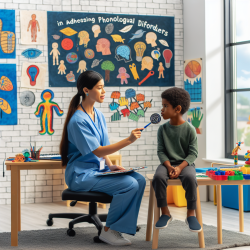Phonological disorders in children represent a significant area of concern and interest for speech-language pathologists and educators. These disorders can impact a child's ability to communicate effectively, influencing their social interactions and academic performance. Drawing insights from the recent compilation "Phonological Disorders in Children: Theory, Research, and Practice," this blog aims to guide practitioners in refining their approach to diagnosing and treating phonological disorders. By exploring the theoretical underpinnings, research findings, and practical applications discussed in this resource, professionals can enhance their skills and strategies for supporting children with these challenges.
Theoretical Perspectives on Phonological Development
The understanding of phonological disorders is grounded in diverse theories of phonological development. These theories range from those emphasizing the innate capabilities of children to those highlighting the role of environmental interactions. Carol Stoel-Gammon's review in the book underscores the importance of integrating these theories to develop a comprehensive model that accounts for the multifaceted nature of phonological acquisition. This integration aids in the creation of more effective assessment and intervention strategies by acknowledging both the child's active role in language learning and the influence of their linguistic environment.
Assessment Procedures and Clinical Applications
Effective assessment is the cornerstone of diagnosing and managing phonological disorders. Pamela Grunwell's evaluation of clinically applicable assessment procedures provides invaluable insights for practitioners. By critiquing various methods based on natural phonology, Grunwell highlights the need for tools that are not only theoretically sound but also practical in clinical settings. This analysis encourages speech-language pathologists to select assessment techniques that align with their clinical objectives, ensuring a thorough understanding of a child's phonological system.
Interactions Between Phonology and Other Linguistic Components
Richard Schwartz's exploration of the interplay between phonology and other linguistic components, such as syntax and lexicon, sheds light on the complexity of phonological disorders. Recognizing these interactions is crucial for developing holistic intervention strategies that address not only phonological errors but also their impact on broader linguistic abilities. This perspective urges clinicians to adopt a more integrated approach to therapy, one that considers the child's overall language system.
Metalinguistic Awareness and Phonological Disorders
The relationship between metalinguistic awareness and phonological disorders, as discussed by Eva Magnussen, offers another layer of understanding. Magnussen's review suggests that enhancing a child's awareness of linguistic structures can play a significant role in remediation. This finding supports the incorporation of metalinguistic tasks in therapy, aiming to improve children's ability to reflect on and manipulate phonological elements of language.
Functional Adequacy of Phonological Systems
Eeva Leinonen's focus on the communicative adequacy of disordered phonological systems emphasizes the ultimate goal of intervention: effective communication. By proposing an index of functional adequacy, Leinonen provides a framework for evaluating the impact of phonological disorders on real-life communication. This approach encourages therapists to prioritize interventions that enhance the child's ability to be understood in various contexts, moving beyond the correction of phonological errors in isolation.
Innovative Intervention Strategies
The book also highlights innovative intervention strategies, such as Barbara Hodson's cyclic phonological therapy and Susanna Evershed-Martin's multidimensional approach. These strategies reflect a shift towards more dynamic and individualized therapeutic methods. By tailoring interventions to the unique needs of each child, practitioners can achieve more meaningful and lasting improvements in phonological skills.
Conclusion
The insights provided in "Phonological Disorders in Children: Theory, Research, and Practice" serve as a valuable resource for speech-language pathologists and educators. By bridging the gap between theory, research, and clinical practice, this compilation offers a comprehensive overview of the current understanding and management of phonological disorders. Practitioners are encouraged to delve deeper into these perspectives and incorporate them into their clinical repertoire, thereby enhancing their ability to support children with phonological disorders effectively.
For those interested in exploring these topics further and accessing the full breadth of research and practical advice, Phonological Disorders in Children: Theory, Research and Practice is an essential read.










